View in other NatureServe Network Field Guides
NatureServe
Montana
Utah
Wyoming
Idaho
Wisconsin
British Columbia
South Carolina
Yukon
California
New York
Common Buckthorn - Rhamnus cathartica
State Rank Reason (see State Rank above)
Rhamnus cathartica is a plant native to Europe and northwestern Asia and introduced into North America (Davis and Mangold 2018). A conservation status rank is not applicable (SNA) because the plant is an exotic (non-native) in Montana that is not a suitable target for conservation activities.
General Description
PLANTS: Large shrubs or small trees that have deciduous leaves and grow 2-6 meters tall. Twigs sometimes end in thorns. Source: Lesica et al. 2012
LEAVES: Both alternate and opposite leaf and bud arrangement can be found on the plant. Young twigs often have opposite or sub-opposite leaf arrangement. Leaf blades are simple, oval, dark green, and glossy. Leaf blades have 3-6 pairs of veins that arc from the mid-vein towards the leaf tip. Leaf margins are finely-toothed. Source: Lesica et al. 2012; Davis and Mangold 2018.
INFLORESCENCE: Plants are either male or female (dioecious). Female plants bear fruit. Female flowers are green, not showy, and have 4 sepals of 1-3 mm long that are longer than the erect petals. Fruits are a 4-seeded drupe, berry-like, and purplish-black at maturity. Source: Lesica et al. 2012; Davis and Mangold 2018.
The genus Rhamnus comes from the Greek word rhamnos meaning prickly shrubs, such as buckthorn (FNA 2016).
Phenology
April through June (FNA 2016).
Diagnostic Characteristics
Common Buckthorn –
Rhamnus cathartica, exotic and Noxious:
* has both alternate and opposite to sub-opposite leaves and buds.
* Leaf blades have 3-6 pairs of veins that arc from the mid-vein towards the leaf tip.
* Leaf tips gradually narrow to a pointed tip.
* Flowers have 4 sepals and petals.
Cascara False Buckthorn –
Frangula purshiana, exotic:
* has both alternate leaves and buds.
* Leaf blades have more than 8 pairs of parallel veins that angle from the mid-vein to the leaf margin.
* Leaf tips abruptly narrow to a short acuminate tip.
* Inflorescence has 4-40 flowers. Flowers have 5 sepals and petals.
Alderleaf Buckthorn –
Rhamnus alnifolia, native and desirable:
* has both alternate leaves and buds.
* Leaf blades have fewer than 8 pairs of parallel veins that angle from the mid-vein to the leaf margin.
* Leaf tips are rounded to acute to abruptly short acuminate tip.
* Inflorescence has 2-5 flowers. Flowers have 5 sepals and petals.
Common Chokecherry –
Prunus virginiana, native and desirable:
* has both alternate leaves and buds.
* Leaf blades have somewhat parallel veins that angle from the mid-vein, but arc near the leaf margin.
* Leaf blades are similar in shape, have finely toothed margins, and gradually narrow to a pointed tip.
* On the leaf petiole, but below the blade are two bumps (raised glands).
* Flowers are arranged in a 3- to 6- inch long raceme, which is conspicuous in the axils of the leaves. Flowers have 5 noticeable, white petals.
Species Range
Montana Range
Range Descriptions
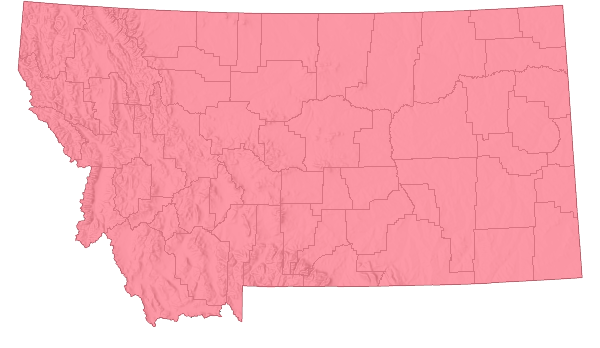
 Non-native
Non-native
Range Comments
Common Buckthorn is native to Europe and northwestern Asia (Davis and Mangold 2018). In the mid-1800s it was introduced to North America as an ornamental shrub for use in hedges, farm shelterbelts, and wildlife habitat (FNA 2016). The first documented specimen came from California in the 1800s (W.H. Brewer, US 18526), but specimens haven’t been collected since and it does not appear naturalized (FNA 2016). Elsewhere in North America it spread into woods and prairies, and in some areas is now considered naturalized (FNA 2016). It occurs throughout much of North America (FNA 2016).
In Montana Common Buckthorn was first documented in Missoula County in 1979 (Consortium of Pacific Northwest Herbaria; http://www.pnwherbaria.org).
For maps and other distributional information on non-native species see:
Nonindigenous Aquatic Species Database from the U.S. Geological Survey
Invasive Species Habitat Tool (INHABIT) from the U.S. Geological Survey
Invasive Species Compendium from the Centre for Agriculture and Bioscience International (CABI)
EDDMapS Species Information EDDMapS Species Information
Observations in Montana Natural Heritage Program Database
Number of Observations: 1491
(Click on the following maps and charts to see full sized version)
Map Help and Descriptions
Relative Density
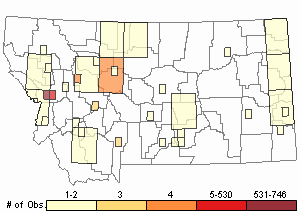
Recency
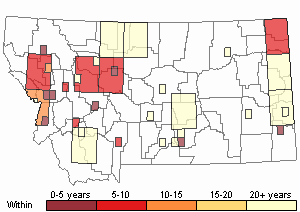
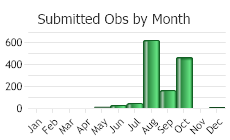
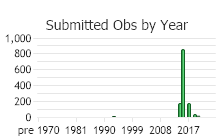
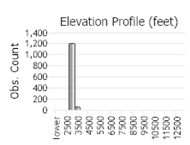 (Observations spanning multiple months or years are excluded from time charts)
(Observations spanning multiple months or years are excluded from time charts)
Habitat
In Montana, Common Buckthorn grows in fields, vacant lots, roadsides, fence rows, and riparian corridors in the plains and valleys (Lesica et al. 2012; Davis and Mangold 2018). It is more abundant in urban areas and adjacent forests (Davis and Mangold 2018). It grows best in moist areas that are not saturated, but have full sun to partial shade, such as along the edge of a forest (Davis and Mangold 2018). It also requires alkaline soils (Davis and Mangold 2018).
Ecology
CULTURALCommon Buckthorn is a potent purgative. Ingestion of the bark, leaves, and fruits cause nausea, vomiting, and diarrhea (Davis and Mangold 2018).
POLLINATORS The following animal species have been reported as pollinators of this plant species or its genus where their geographic ranges overlap:
Bombus mixtus and
Bombus pensylvanicus (Thorp et al. 1983, Colla and Dumesh 2010).
Reproductive Characteristics
Common Buckthorn reproduces only by seed. Seeds either fall beneath their parent plant or are dispersed by birds and small mammals who eat the fruits and excrete the seeds (Davis and Mangold 2018).
Management
Common Buckthorn was added to the Montana noxious weed list in 2017 (Davis and Mangold 2018).
Proper identification, early detection, and eradication is the best way to prevent Common Buckthorn from establishing. Large infestations are difficult to control. Methods should focus on controlling female shrubs which bear fruit and are responsible for dispersal. Control methods usually involve both mechanical and chemical methods. When prioritizing, sites with low-densities should be targeted because they are less costly to recover, are more likely to be returned to a native-dominant habitat, and efforts will aid in reducing spread by seed production (Davis and Mangold 2018).
PREVENTIONLandowners should frequently monitor their land for new infestations and, when found to implement effective control methods.
PHYSICAL and CULTURAL CONTROLS [Adapted from Davis and Mangold 2018]
Hand-pulling or
mowing can be done on seedlings with stems up to 1.5 inches in diameter. Mowing will not kill plants.
Prescribed burning can kill plants, but will likely not eliminate plants. Spring burns can kill first-year seedlings and may eliminate established plants depending upon the burn (Panke and Renz 2012). However, burning also stimulates germination from the seed bank. Repeated burning or burning in combination with herbicides may be more effective. A 5-second exposure of flame around the stem with a propane torch will kill plants with a diameter of up to 2-inches (Panke and Renz 2012).
GRAZING CONTROLS Currently information is unknown.
CHEMICAL CONTROLS [Adapted from Davis and Mangold 2018]
The herbicide type and concentration, application time and method, environmental constraints, land use practices, local regulations, and other factors will determine its effectiveness and impact to non-target species. Strict adherence to application requirements defined on the herbicide label will reduce risks to human and environmental health. Consult your County Extension Agent and/or Weed District for information on herbicidal control. Consult your County Extension Agent and/or Weed District for more information on herbicidal control. Chemical information is also available at
Greenbook.
It is recommended that foliar applications of herbicides be applied in the late fall to reduce negative impacts to native and/or desirable vegetation and wildlife. Foliar applications of
glyphosate,
triclopyr, or mixed
tripclopyr and 2,4-D have been used on dense stands of small individuals.
Glyphosate is a systemic herbicide that will kill the root system, but it also is not selective and can kill all plants.
For large female shrubs with stems greater than 6 inches in diameter, control can occur by cutting and applying an herbicide. Stems that are girdled or cut, but not herbicided will develop new shoots. In riparian areas, female shrubs can be cut and piled. If there are fruits the pile should be burned to prevent seed dispersal. Additional chemical information used in the mid-west can be found at Panke and Renz 2012.
BIOLOGICAL CONTROLS Currently no biological control agents are available.
Useful Links:Montana Invasive Species websiteMontana Biological Weed Control Coordination ProjectMontana Department of Agriculture - Noxious WeedsMontana Weed Control AssociationMontana Weed Control Association Contacts Webpage.
Montana Fish, Wildlife, and Parks - Noxious WeedsMontana State University Integrated Pest Management ExtensionWeed Publications at Montana State University Extension - MontGuidesStewardship Responsibility
Threats or Limiting Factors
Common Buckthorn strongly competes for light, nutrients, and water and can out-grow or out-compete many native species in Montana (Davis and Mangold 2018). It can form dense, impenetrable thickets that decrease plant diversity, hinders access for recreationalists, and alters wildlife use or habitat.
Common Buckthorn is a winter host for the Soybean Aphid, Aphis glycines (FNA 2016). The Soybean Aphid is native to eastern Asia and was first found in North America in Wisconsin in 2000. It has since spread. Infected plants produce orange-colored wood that is sometimes used by wood carvers.
References
- Literature Cited AboveLegend:
 View Online Publication
View Online Publication Colla, S.R. and S. Dumesh. 2010. The bumble bees of southern Ontario: notes on natural history and distribution. Journal of the Entomological Society of Ontario 141:39-68.
Colla, S.R. and S. Dumesh. 2010. The bumble bees of southern Ontario: notes on natural history and distribution. Journal of the Entomological Society of Ontario 141:39-68. Flora of North America Editorial Committee, eds. 2016. Flora of North America north of Mexico, Vol. 12. Magnoliophyta: Vitaceae to Garryaceae. Oxford University Press, Inc. New York.
Flora of North America Editorial Committee, eds. 2016. Flora of North America north of Mexico, Vol. 12. Magnoliophyta: Vitaceae to Garryaceae. Oxford University Press, Inc. New York. Lesica, P., M.T. Lavin, and P.F. Stickney. 2012. Manual of Montana Vascular Plants. Fort Worth, TX: BRIT Press. viii + 771 p.
Lesica, P., M.T. Lavin, and P.F. Stickney. 2012. Manual of Montana Vascular Plants. Fort Worth, TX: BRIT Press. viii + 771 p. Panke, Brendon and Mark Renz. 2012. Management of Invasive Plants in Wisconsin: Common Buckthorn and Glossy Buckthorn. A3924-02. January 10, 2012. University of Wisconsin-Cooperative Extension, Madison, Wisconsin.
Panke, Brendon and Mark Renz. 2012. Management of Invasive Plants in Wisconsin: Common Buckthorn and Glossy Buckthorn. A3924-02. January 10, 2012. University of Wisconsin-Cooperative Extension, Madison, Wisconsin. Thorp, R.W., D.S. Horning, and L.L. Dunning. 1983. Bumble bees and cuckoo bumble bees of California (Hymenoptera: Apidae). Bulletin of the California Insect Survey 23:1-79.
Thorp, R.W., D.S. Horning, and L.L. Dunning. 1983. Bumble bees and cuckoo bumble bees of California (Hymenoptera: Apidae). Bulletin of the California Insect Survey 23:1-79.
- Additional ReferencesLegend:
 View Online Publication
View Online Publication
Do you know of a citation we're missing? Davis, Stacy and Jane Mangold. 2018. Common Buckthorn. MontGuide MT201708AG. Reprinted October 2018. Montana State University-Extension, Bozeman, Montana.
Davis, Stacy and Jane Mangold. 2018. Common Buckthorn. MontGuide MT201708AG. Reprinted October 2018. Montana State University-Extension, Bozeman, Montana. Lesica, P., M.T. Lavin, and P.F. Stickney. 2022. Manual of Montana Vascular Plants, Second Edition. Fort Worth, TX: BRIT Press. viii + 779 p.
Lesica, P., M.T. Lavin, and P.F. Stickney. 2022. Manual of Montana Vascular Plants, Second Edition. Fort Worth, TX: BRIT Press. viii + 779 p. Little, E.L., Jr. 1979. Checklist of United States trees (native and naturalized). Agriculture Handbook No. 541. U.S. Forest Service, Washington, D.C. 375 pp.
Little, E.L., Jr. 1979. Checklist of United States trees (native and naturalized). Agriculture Handbook No. 541. U.S. Forest Service, Washington, D.C. 375 pp. Sater, S. 2022. The insects of Sevenmile Creek, a pictorial guide to their diversity and ecology. Undergraduate Thesis. Helena, MT: Carroll College. 242 p.
Sater, S. 2022. The insects of Sevenmile Creek, a pictorial guide to their diversity and ecology. Undergraduate Thesis. Helena, MT: Carroll College. 242 p.
- Web Search Engines for Articles on "Common Buckthorn"





